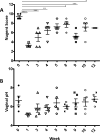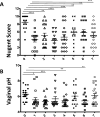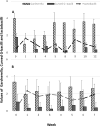Comparison of the vaginal environment in rhesus and cynomolgus macaques pre- and post-lactobacillus colonization
- PMID: 28488364
- PMCID: PMC5597444
- DOI: 10.1111/jmp.12264
Comparison of the vaginal environment in rhesus and cynomolgus macaques pre- and post-lactobacillus colonization
Abstract
Background: Rhesus and cynomologus macaques are valuable animal models for the study of human immunodeficiency virus (HIV) prevention strategies. However, for such studies focused on the vaginal route of infection, differences in vaginal environment may have deterministic impact on the outcome of such prevention, providing the rationale for this study.
Methods: We tested the vaginal environment of rhesus and cynomolgus macaques longitudinally to characterize the normal microflora based on Nugent scores and pH. This evaluation was extended after colonization of the vaginal space with Lactobacilli in an effort to recreate NHP models representing the healthy human vaginal environment.
Results and conclusion: Nugent scores and pH differed significantly between species, although data from both species were suggestive of stable bacterial vaginosis. Colonization with Lactobacilli was successful in both species leading to lower Nugent score and pH, although rhesus macaques appeared better able to sustain Lactobacillus spp over time.
Keywords: lactobacillus; macaque; microbiota; vagina.
© 2017 John Wiley & Sons A/S. Published by John Wiley & Sons Ltd.
Figures






Similar articles
-
Directed shift of vaginal microbiota induced by vaginal application of sucrose gel in rhesus macaques.Int J Infect Dis. 2015 Apr;33:32-6. doi: 10.1016/j.ijid.2014.12.040. Epub 2014 Dec 26. Int J Infect Dis. 2015. PMID: 25546169
-
A Chinese rhesus macaque (Macaca mulatta) model for vaginal Lactobacillus colonization and live microbicide development.J Med Primatol. 2009 Apr;38(2):125-36. doi: 10.1111/j.1600-0684.2008.00316.x. J Med Primatol. 2009. PMID: 19367737 Free PMC article.
-
Metagenomic comparison of the rectal microbiota between rhesus macaques (Macaca mulatta) and cynomolgus macaques (Macaca fascicularis).Zool Res. 2019 Mar 18;40(2):89-93. doi: 10.24272/j.issn.2095-8137.2018.061. Epub 2018 Aug 8. Zool Res. 2019. PMID: 30127329 Free PMC article.
-
Cutting edge: the vaginal microflora and bacterial vaginosis.Verh K Acad Geneeskd Belg. 2008;70(3):147-74. Verh K Acad Geneeskd Belg. 2008. PMID: 18669158 Review.
-
Vaginal Microbiota.Adv Exp Med Biol. 2016;902:83-93. doi: 10.1007/978-3-319-31248-4_6. Adv Exp Med Biol. 2016. PMID: 27161352 Review.
Cited by
-
Advances in vaginal bioengineering: Applications, techniques, and needs.Curr Res Physiol. 2023 Oct 18;6:100111. doi: 10.1016/j.crphys.2023.100111. eCollection 2023. Curr Res Physiol. 2023. PMID: 38107786 Free PMC article. Review. No abstract available.
-
Protection Efficacy of C5A Against Vaginal and Rectal HIV Challenges in Humanized Mice.Open Virol J. 2018 Feb 28;12:1-13. doi: 10.2174/1874357901812010001. eCollection 2018. Open Virol J. 2018. PMID: 29541273 Free PMC article.
-
Microbiome Studies in Non-human Primates.Curr HIV/AIDS Rep. 2021 Dec;18(6):527-537. doi: 10.1007/s11904-021-00584-9. Epub 2021 Nov 4. Curr HIV/AIDS Rep. 2021. PMID: 34735686 Free PMC article. Review.
-
Anti-HIV-1 Activity of Lactic Acid in Human Cervicovaginal Fluid.mSphere. 2018 Jul 5;3(4):e00055-18. doi: 10.1128/mSphere.00055-18. mSphere. 2018. PMID: 29976641 Free PMC article.
References
-
- Van Damme L, et al. Lack of effectiveness of cellulose sulfate gel for the prevention of vaginal HIV transmission. New England Journal of Medicine. 2008;359(5):463–472. - PubMed
Publication types
MeSH terms
Grants and funding
LinkOut - more resources
Full Text Sources
Other Literature Sources
Miscellaneous

